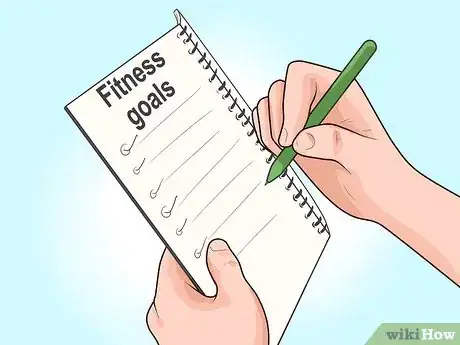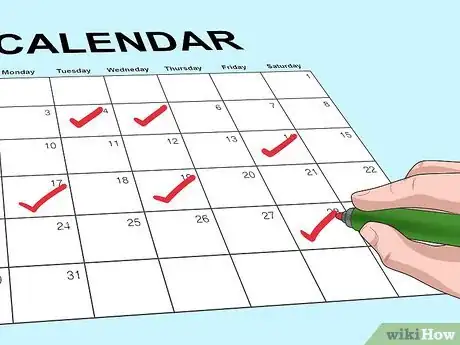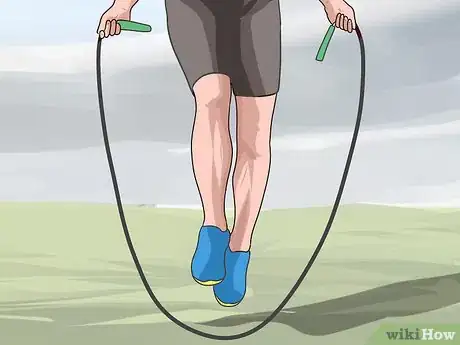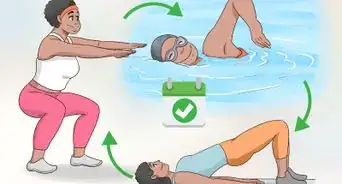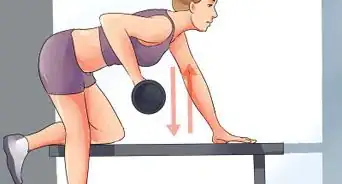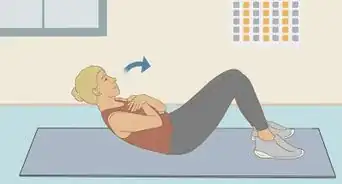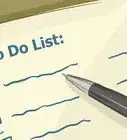This article was co-authored by Danny Gordon. Danny Gordon is an American College of Sports Medicine (ACSM) Certified Personal Trainer and Owner of The Body Studio for Fitness, a fitness studio based in the San Francisco Bay Area. With over 20 years of physical training and teaching experience, he has focused his studio on semi-private personal training. Danny received his Personal Trainer Certification from the California State University, East Bay and the American College of Sports Medicine (ACSM).
There are 13 references cited in this article, which can be found at the bottom of the page.
This article has been viewed 152,625 times.
Adding fitness and exercise into your daily routine is an ideal way to benefit your health. When your life is busy enough as it is, and you have a set work schedule in place, scheduling daily workouts can feel tricky. However, with the proper goals and mindset, you can take steps to make fitness a daily routine.
Steps
Setting Goals
-
1Select your fitness goals. If you’re just building up a fitness regimen, you may not have a clear idea of exactly what you want to achieve. You may not even know what your body is capable of. That’s fine; even simply wanting to be stronger is a solid starting point. In general, it’s healthier and more effective to focus on strength you want to build or activities you want to perform, as opposed to a certain look.[1]
- Some sample goals include: running a 5K without stopping, touching your toes, lifting your own weight above your head, and doing the splits.
- Some fitness programs and diets even discourage you from weighing or measuring yourself as you change your routines.[2] Getting bogged down in the look of your body can distract you from what it can do.
- Write down your goals in a notebook and set an alarm to look at them in 3 months, 6 months, or a year.
-
2Pick a realistic timeframe. Building a new routine can be tricky: it takes about 2 months for a new habit to become second nature.[3] Still, you want to set goals that don’t feel too distant. Many fitness experts recommend a 3 month timeframe: a season is long enough that you can accomplish a great deal, but not so lengthy that you feel like you’ll never see the end of it.[4]
- Some races and events, like marathons, have a somewhat standardized recommended training schedule.[5]
- It’s okay to have smaller mini-goals. For instance, you may want to increase your resistance by 10% every 2 weeks on a certain exercise.
- Remember that working out every day is a goal in and of itself.
Advertisement -
3Seek out expert advice. Every body is different, and everyone’s goals are too. Because of this, there’s rarely one-size-fits-all fitness advice. You are powerfully positioned to learn, because you know yourself and your aims better than anyone does. Put some time in to learn what types of exercise will suit you and which ones you like. There are plenty of resources out there to help.
- Though it can’t replace an instructor who watches you in person, the Internet has many reliable fonts of fitness information. Start with the President's Council on Fitness page.
- If you aren't ready to venture outside with your fitness routine, there are plenty of workouts on YouTube that you can do at home with no equipment. Try Blogilates or Fitness Blender.
-
4Try out a gym. If you have the option, do trial workouts at different gyms until you find a vibe you like. Even better, most gyms offer orientations, where an expert can show you how to use different types of equipment to safely maximize your workout. There are many criteria for selecting the perfect gym, including:[6]
- Is it easy for you to get to?
- Is it usually full? Can you easily access equipment?
- Do you feel comfortable around the other members?
-
5Experiment with group classes. Group classes offer the benefits of in-person instruction for beginners without the pressures of personal training. Plus, the regular schedules and presence of other fitness enthusiasts can help you stay motivated.[7]
- If you're trying to figure out what you like, try a service like Groupon or ClassPass. These offer a discounted pack of classes, so you can figure out if you're really into hot yoga or spinning before committing to them.
-
6Pace yourself. It’s admirable to want to push yourself, but you can’t turn from a couch potato into a track star in a week. Exhaustion is real, and burnout can negatively impact your ability to reach your goals.[8] Work your way slowly up to your exercise goals. For example, if you want to run, start out by walking at a brisk pace until your body feels comfortable and ready for jogging or running.[9]
- Walk up and down flights of stairs instead of taking elevators or escalators, and park your automobile in the farthest spot away from your destination to increase your daily activity in the beginning.
- If you’re too tired for a full workout one day but still want to move, take a long walk or do house or yard work.
Saving Time
-
1Schedule your workouts. You will best adhere to a routine if you designate daily times for exercise. Without a specific timeframe, you may be more likely to stray from your daily fitness commitment. Once you’ve been scheduling them for a month or two, your workouts will feel like a natural part of your day, just like showering or eating breakfast.
- You can split your workout into chunks if necessary (for instance, running before breakfast and Pilates after work).
- Make a new color in your calendar for fitness, and officially mark off a block of time for it every day.
- Choose a time that complements your daily schedule. For example, if you join a gym located near your place of work, you can exercise early in the morning before you go to work, or in the afternoons or evenings following your work shift.
-
2Find a workout buddy. If you’re more likely to keep social obligations than promises to yourself, it might help you to plan your workouts for two. Many people find that this helps them keep to their workouts, and, as a bonus, makes them enjoy their time. It’s a win-win.[10]
- Try to find a buddy who’s at a similar level to you, so you can grow together. If one of you is much more experienced than the other, it might throw off the “buddy” power dynamic.
- If you’re a long-distance runner and you live in a town or city, there are probably multiple running groups you can join. Ask around!
-
3Pack your equipment ahead of time. This way, you can go to your workout without taking the extra time to prepare, which can be helpful if your daily schedule is extremely busy. Put together your gym bag for the following day before you go to bed, or keep your fitness equipment in your car or in a locker at the gym.
- If you keep your gym bag in your room, consider keeping it some place that is easy to see. This might help motivate you for the next day.
- If you keep your equipment in the car, remember to take it home each day so that you can clean your clothes and air out your bag.
-
4Stretch every time you exercise. It may seem counterintuitive because it adds an extra 10 minutes at the end of your workout, but stretching may protect you from a lot of soreness tomorrow. Furthermore, it helps build flexibility and is a nice way to cool down your mind as well as your body at the end of a tough session.[11]
- Be sure to do a comprehensive stretching routine that stretches all the major muscle groups.
-
5Move every day. On average, an adult body needs at least 30 minutes of exercise daily.[12] It’s hard to get that in sometimes, so try to have some backup workouts in mind in case you can’t make it to the gym or jog a 5k.
- For instance, you might jump rope or do a half-hour YouTube Zumba routine that challenges you. If all else fails, turn on your favorite music and have a solo dance party
Staying Motivated
-
1Enjoy your workout. You will be more likely to establish and adhere to a daily routine if you genuinely enjoy the activity you are performing. For example, if you enjoy playing a specific sport, join a neighborhood team. If being lonely bums you out, find group motivation in a bootcamp class.[13]
- You might have to experiment to find things you like, but that’s part of the journey.
-
2Play fun music. Whatever makes you energized is ideal. Plenty of people are embarrassed by their workout music, but if a particular boy band pushes you to run a couple more miles, who cares? As long as it energizes you, play it!
- If you feel self-conscious about your music, put on some headphones so that only you can hear it.
- If you're stuck on finding the perfect jams, services like Spotify and IHeartRadio often curate workout playlists, so start with those.
-
3Mix it up. As you continue to exercise, your routine may begin to feel more like a rut. Don’t let that happen--if you start getting sick of exercise, experiment with something new. Trying different things will challenge your body to move in new ways, which will both make you stronger and keep you from being bored.[14]
- Build off of something you’ve done before. If you’ve liked Zumba, maybe it’s time to try a salsa dancing class.
- Alternately, try something totally different. If you love lifting weights, yoga just might increase your core strength and your mental clarity.
-
4Consult an expert. A certified fitness trainer can help you push yourself, both on days when you see them and on days when you work out solo. Inquire at your gym to find trainers, or ask people you trust if they have recommendations.
- Pick a trainer you feel comfortable with. You won’t be able to improve if you feel scared, intimidated, or talked down to.
- You don’t need to go every week--a good trainer will help you craft a routine that continues to grow with you.
-
5Eat right. Nutrition isn’t an exact science and different bodies need different things, but if you want to keep working out and seeing good results, you need to power yourself with the right food. Cutting down on both alcohol and caffeine can be helpful, but the food that will suit you best depends on how you like to work out.[15]
- Eat carbs if you’re going to be doing lots of cardio. Whole grains, berries and fruits contain slow-burning sugars that will keep you going.[16]
- Protein reinforces strength and weight training. Grilled chicken and spinach is a classic post-workout meal, while chocolate milk provides the right proportion of protein to carbs in a convenient post-workout drink.[17]
-
6Listen to your body. If you exercise on a daily basis even on days when you are especially tired or sore, you may become resentful of your fitness routine and lose the motivation to work out. Allow your body to rest and recover one day per week. If you feel guilty about missing a workout, or want to maintain a routine even when you are tired, take a walk or go for a hike.
- There is nothing wrong with taking a day off from working out. In fact, many trainers recommend this, as it allows your body to recoup and recover.
Weekly Fitness Routine
Expert Q&A
Did you know you can get expert answers for this article?
Unlock expert answers by supporting wikiHow
-
QuestionHow do you make a good workout routine?
 Danny GordonDanny Gordon is an American College of Sports Medicine (ACSM) Certified Personal Trainer and Owner of The Body Studio for Fitness, a fitness studio based in the San Francisco Bay Area. With over 20 years of physical training and teaching experience, he has focused his studio on semi-private personal training. Danny received his Personal Trainer Certification from the California State University, East Bay and the American College of Sports Medicine (ACSM).
Danny GordonDanny Gordon is an American College of Sports Medicine (ACSM) Certified Personal Trainer and Owner of The Body Studio for Fitness, a fitness studio based in the San Francisco Bay Area. With over 20 years of physical training and teaching experience, he has focused his studio on semi-private personal training. Danny received his Personal Trainer Certification from the California State University, East Bay and the American College of Sports Medicine (ACSM).
Certified Personal Trainer So you want to make sure that you're getting a good combination of cardio, strength training, and flexibility training. You also want to make sure that you're targeting every part of your body, so choose a good combination of lower body and upper body exercises. Keep in mind, you don't need to do all of this every day. You can do leg strength training one day, cardio the next day, and upper body strength training the next.
So you want to make sure that you're getting a good combination of cardio, strength training, and flexibility training. You also want to make sure that you're targeting every part of your body, so choose a good combination of lower body and upper body exercises. Keep in mind, you don't need to do all of this every day. You can do leg strength training one day, cardio the next day, and upper body strength training the next. -
QuestionShould you stretch before or after your workout?
 Danny GordonDanny Gordon is an American College of Sports Medicine (ACSM) Certified Personal Trainer and Owner of The Body Studio for Fitness, a fitness studio based in the San Francisco Bay Area. With over 20 years of physical training and teaching experience, he has focused his studio on semi-private personal training. Danny received his Personal Trainer Certification from the California State University, East Bay and the American College of Sports Medicine (ACSM).
Danny GordonDanny Gordon is an American College of Sports Medicine (ACSM) Certified Personal Trainer and Owner of The Body Studio for Fitness, a fitness studio based in the San Francisco Bay Area. With over 20 years of physical training and teaching experience, he has focused his studio on semi-private personal training. Danny received his Personal Trainer Certification from the California State University, East Bay and the American College of Sports Medicine (ACSM).
Certified Personal Trainer
-
QuestionIs yoga a good way to exercise?
 Danny GordonDanny Gordon is an American College of Sports Medicine (ACSM) Certified Personal Trainer and Owner of The Body Studio for Fitness, a fitness studio based in the San Francisco Bay Area. With over 20 years of physical training and teaching experience, he has focused his studio on semi-private personal training. Danny received his Personal Trainer Certification from the California State University, East Bay and the American College of Sports Medicine (ACSM).
Danny GordonDanny Gordon is an American College of Sports Medicine (ACSM) Certified Personal Trainer and Owner of The Body Studio for Fitness, a fitness studio based in the San Francisco Bay Area. With over 20 years of physical training and teaching experience, he has focused his studio on semi-private personal training. Danny received his Personal Trainer Certification from the California State University, East Bay and the American College of Sports Medicine (ACSM).
Certified Personal Trainer
Warnings
- After your first day of fitness, you may hurt because your muscles haven't gotten used to exercising.⧼thumbs_response⧽
References
- ↑ Danny Gordon. Certified Fitness Coach. Expert Interview. 18 October 2019.
- ↑ http://whole30.com/whole30-program-rules/
- ↑ http://www.huffingtonpost.com/james-clear/forming-new-habits_b_5104807.html
- ↑ http://www.autostraddle.com/get-fit-staying-motivated-so-you-just-dont-stop-129574/
- ↑ http://www.halhigdon.com/training/51135/Marathon-Training-Guide
- ↑ https://www.nerdfitness.com/blog/2013/03/18/strength-training-101-finding-the-right-gym/
- ↑ http://www.active.com/fitness/articles/6-benefits-of-group-fitness-classes
- ↑ https://www.competitivedge.com/burn-out
- ↑ Danny Gordon. Certified Fitness Coach. Expert Interview. 18 October 2019.
- ↑ http://www.fitnessmagazine.com/mind-body/inspiration/7-ways-to-find-a-fitness-buddy/
- ↑ Danny Gordon. Certified Fitness Coach. Expert Interview. 18 October 2019.
- ↑ http://www.webmd.com/fitness-exercise/guide/your-exercise-routine-how-much-is-enough
- ↑ http://www.fitnessmagazine.com/weight-loss/tips/advice/extrovert-workouts/
- ↑ Danny Gordon. Certified Fitness Coach. Expert Interview. 18 October 2019.
- ↑ Danny Gordon. Certified Fitness Coach. Expert Interview. 18 October 2019.
- ↑ http://running.competitor.com/2014/04/photos/the-10-best-carbohydrate-sources-for-runners_12953
- ↑ http://www.fitnessmagazine.com/recipes/healthy-eating/superfoods/chocolate-milk-after-workout/
